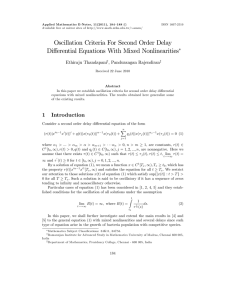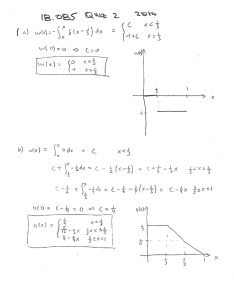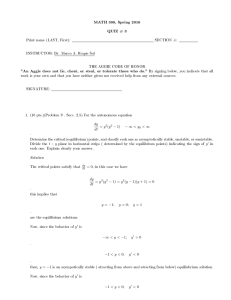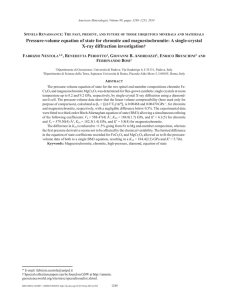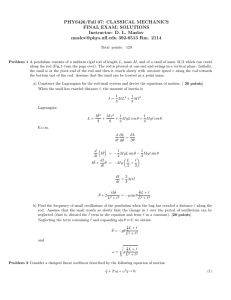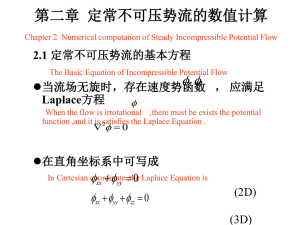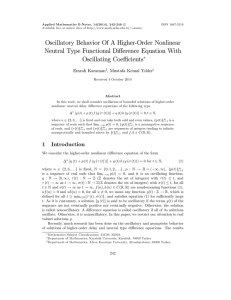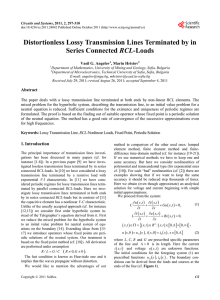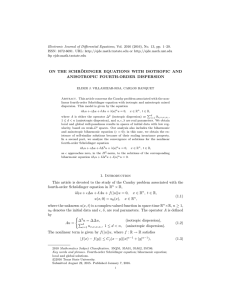Document 10677316
advertisement
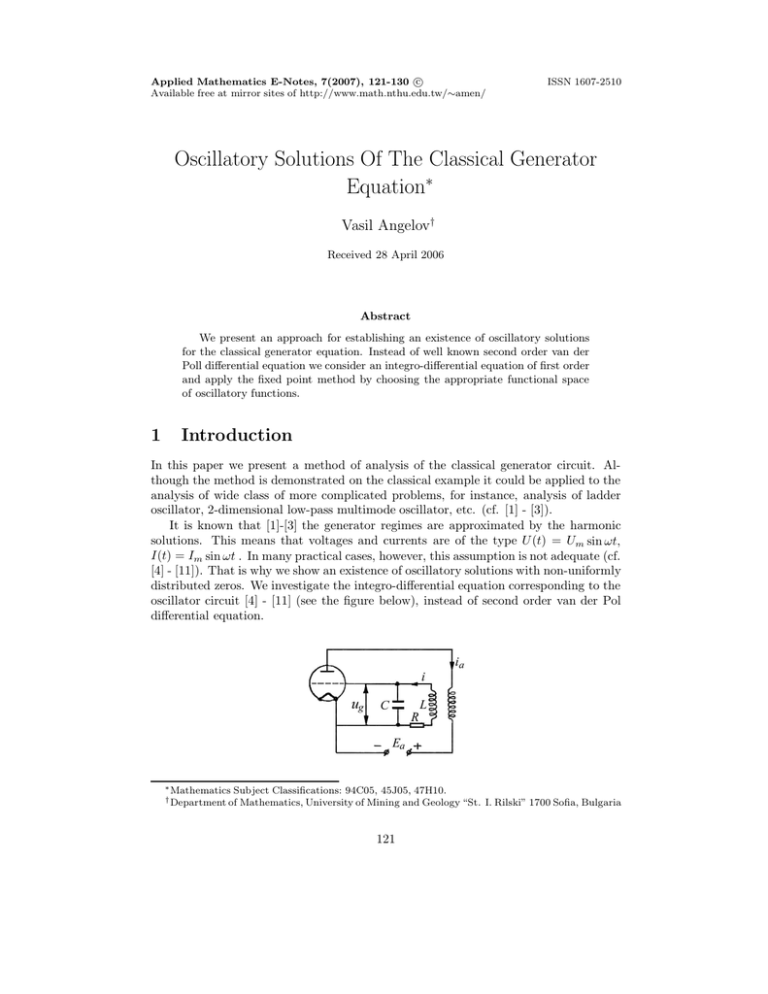
c
Applied Mathematics E-Notes, 7(2007), 121-130 Available free at mirror sites of http://www.math.nthu.edu.tw/∼amen/
ISSN 1607-2510
Oscillatory Solutions Of The Classical Generator
Equation∗
Vasil Angelov†
Received 28 April 2006
Abstract
We present an approach for establishing an existence of oscillatory solutions
for the classical generator equation. Instead of well known second order van der
Poll differential equation we consider an integro-differential equation of first order
and apply the fixed point method by choosing the appropriate functional space
of oscillatory functions.
1
Introduction
In this paper we present a method of analysis of the classical generator circuit. Although the method is demonstrated on the classical example it could be applied to the
analysis of wide class of more complicated problems, for instance, analysis of ladder
oscillator, 2-dimensional low-pass multimode oscillator, etc. (cf. [1] - [3]).
It is known that [1]-[3] the generator regimes are approximated by the harmonic
solutions. This means that voltages and currents are of the type U (t) = Um sin ωt,
I(t) = Im sin ωt . In many practical cases, however, this assumption is not adequate (cf.
[4] - [11]). That is why we show an existence of oscillatory solutions with non-uniformly
distributed zeros. We investigate the integro-differential equation corresponding to the
oscillator circuit [4] - [11] (see the figure below), instead of second order van der Pol
differential equation.
∗ Mathematics
Subject Classifications: 94C05, 45J05, 47H10.
Mathematics, University of Mining and Geology “St. I. Rilski” 1700 Sofia, Bulgaria
† Department of
121
122
The Classical Generator Equation
Indeed, the second Kirchoff’s law applied to the foregoing circuit yields
1
di(t)
+ Ri(t) +
L
dt
C
Z
t
i(s)ds = M
t0
dia
dt
(1)
with unknown function i = i(t) - the circuit current. The constants L, R, C and M
have the usually accepted sense (cf. [4] - [11]) while ia = ia (t) is the anode current.
Rt
In view of the relation between the grid voltage ug and current ug (t) = C1 t0 i(s)ds
and taking into account the tube V-I characteristics ia = ia (ug ), one can derive the
second order differential equation:
d2 ug (t)
dia dug
LC
+ RC − M
(2)
+ ug = 0.
dt2
dug
dt
If ia = ia (ug ) is a linear function, then obviously (2) becomes a linear differential
equation. If, however, the tube V-I characteristic is approximated by a third order
dia
polynomial, ia (ug ) = Ia0 + Sug − Qu3g (Ia0 ,S,Q are prescribed constants), then du
=
g
S − 3Qu2g . Consequently, substituting the foregoing expression in (2), we obtain a
nonlinear second order differential equation:
LC
dug
d2ug (t)
+ RC − M S + 3M Qu2g
= 0,
2
dt
dt
(3)
which is the well known van der Pol equation considered in a lot of papers (cf. for
instance [4] - [11]).
Our approach is based on the primary integro-differential equation (1). We assume
the unknown function to be the current i = i(t). Then in view of dug /dt = i(t)/C and
substituting in (1) we obtain
"
Z t
2 #
Z
di(t)
i(t)
1
1 t
L
i(s)ds = M S − 3Q
i(τ )dτ
+ Ri(t) +
dt
C t0
C t0
C
or introducing the denotations
A1 =
M S − RC
,
LC
A2 = −
1
,
LC
A3 = −
3M Q
,
LC 3
we have
di(t)
= A1 i(t) + A2
dt
Z
t
i(s)ds + A3 i(t)
t0
Z
t
t0
2
Z t
i(s)ds ≡ F i(t),
i(s)ds
(4)
t0
where F (x, y) = A1 x + A2 y + A3xy2 .
Another example of integro-differential system arises in the analysis of line array of
oscillators [1]:
Z t
1
Ik (t) =
[Uk (τ ) − Uk+1 (τ )] dτ,
L0 t0
V. Angelov
123
Ik−1 − Ik = C
dUk
1
+
d(t) L
Z
t
Uk (τ )dτ + gUk (t) − g1 Uk (t) + g3 Uk3(t), k = 1, 2, ..., N.
t0
The usually accepted approach to solve the above system is to reduce it to the second
order system of van der Pol type (cf. [1]):
0
=
dUk
3g3
1
2
d2 Uk (t) g1 − g
2
−
(t)
1
−
U
+
+
Uk (t)
dt2
C
g1 − g k
dt
LC
L0C
1
1
−
Uk−1(t) −
Uk+1 (t).
L0 C
L0 C
Instead of the above system one can consider the following one:
Z t
Z t
dUk (t)
1
1
2
[Uk+1 (τ ) + Uk−1(τ )] dτ −
Uk (τ )dτ −
=
+
dt
L0 C t0
LC
L0 C
t0
g − g1
g3
−
Uk (t) − Uk3(t)
C
C
= 0,
which is of the type (4).
2
Φ-Contractive Mappings in Uniform Spaces
Here we recall fixed point theorems for Φ-contractive mappings in uniform spaces introduced in [12]. The uniform spaces turn out a natural extension of the metric spaces.
The particular case of the uniform spaces are the locally convex topological vector
spaces whose topology is uniformizable (cf.[12]). Therefore the fixed point results from
[12] are valid in locally convex spaces, too.
By (X, =) we mean a Hausdorff (T2 -separated) sequentially complete uniform space
whose uniformity is generated by a saturated family of pseudometrics
= = {dk (x, y) : k ∈ A} ,
where A is an index set. Let (Φ) = {Φk (t) : k ∈ A} be a family of functions (which we
shall call Φ -contractive) with the properties:
(Φ1) for every k ∈ A Φk (t) : R1+ → R1+ is monotone increasing and continuous
from the right;
(Φ2) for every k ∈ A it follows 0 < Φk (t) < t for t > 0 (by right continuity
Φk (0) = 0).
Let j : A → A be a mapping of the index set A into itself. The iterations of j can be
defined as follows:j 0(k) = k, j n (k) = j j n−1 (k) (n = 1, 2, ...). A mapping T : X → X
is said to be Φ-contractive if dk (T x, T y) ≤ Φk (dj(k)(x, y)) for every x, y ∈ X and k ∈ A.
THEOREM 2.1 ([12]). Let the following conditions be fulfilled:
1) the operator T : X → X is Φ-contractive;
124
The Classical Generator Equation
2) for every k ∈ A there exists a function
Φk (t) which possesses the properties of
(Φ) such that sup Φj n (k)(t) : n = 0, 1, 2, ... ≤ Φk (t) and Φk (t)/t is monotone nondecreasing;
3) there is x0 ∈ X such that dj n(k) (x0, T x0) ≤ q(k, x0) <∝ (n = 0, 1, 2, ...) for some
q > 0.
Then T has at least one fixed point in X.
A uniform space (X, =) is said to be j-bounded if for every k ∈ A and x, y ∈ X
there exists q = q(x, y, k) such that dj n(k)(x, y) ≤ q(x, y, k) <∝ (n = 0, 1, 2, ...). It is
easy to verify that j-boundedness of (X, =) implies condition 3) of the last Theorem
2.1.
THEOREM 2.2 ([12]). If to the conditions of Theorem 2.1 we add the assumption
that X is j-bounded, then T has a unique fixed point in X.
3
An Existence of Oscillatory Solutions
Now we are able to formulate the main problem for (4): to find an oscillatory solution
of (4) on an interval [t0, ∝). Without loss of generality one can choose the initial value
to be i(t0 ) = i0 = 0.
∝
Let S = {tk }k=0 be an increasing sequence of real numbers satisfying the following
conditions:
(t1) limk→∝ tk =∝ ;
(t2) 0 < inf {tk+1 − tk : k = 0, 1, 2, ...} ≤ sup {tk+1 − tk : k = 0, 1, 2, ...} ≤ T0 <∝.
Let CS [t0, ∝) CS1 [t0 , ∝) be the set of all continuously (continuously differentiable)
functions f(t) : [t0, ∝) → (− ∝, ∝) with zeros at S, that is, f(tk ) = 0, (k = 0, 1, ...).
Introduce the sets
Z tk+1
M = f ∈ CS [t0, ∝) :
f(t)dt = 0; k = 0, 1, 2, ...
tk
M1 =
Z
f ∈ CS1 [t0, ∝) :
tk+1
f(t)dt = 0; k = 0, 1, 2, ... .
tk
Then it is obvious every primitive function F (t) =
f(.) ∈ M .
Rt
t0
f(τ )dτ has zeros at S provided
LEMMA 3.1. Equation (4) has a continuously differentiable oscillatory solution
i(.) ∈ M1 iff the operator G has a fixed point in M , that is,
i(t) = (Gi)(t)
(5)
Rt
Rs
Rt
Rs
where (Gi)(t) =: i(tk+1 ) + tk F i(s), t0 i(τ )dτ ds ≡ tk F i(s), t0 i(τ )dτ ds, t ∈
[tk , tk+1] (k = 0, 1, 2, 3, ...) (cf.[13]).
Rt
Rt
Rt
Rt
REMARK 1. Note that t0 i(s)ds = t0k i(s)ds+ tk i(s)ds = tk i(s)ds, t ∈ [tk , tk+1].
V. Angelov
125
PROOF. Let i(.) ∈ M1 be an oscillatory solution of (4). Then integrating (4) on
every interval [tk , t] ⊂ [tk , tk+1](k = 0, 1, 2, ...) we obtain
Z t Z s
i(t) =
F i(s),
i(τ )dτ ds
(6)
tk
t0
that is, G has a fixed point. In what follows we show that the fixed point belongs to
M . But i(.) ∈ M1 and substituting t = tk+1 we obtain
Z tk+1 Z s
i(tk+1 ) =
F i(s),
i(τ )dτ ds = 0.
tk
tk
Following [13] we obtain that
Z s
Z tk+1 1
i(s) + sF i(s),
i(τ )dτ
ds = i(tk+1 ) = 0 (k = 0, 1, 2, ...).
tk+1 − tk tk
t0
Consequently (5) can be written in the form:
Z s
Z tk+1 1
i(t) =
i(s) + sF i(s),
i(τ )dτ
ds +
tk+1 − tk tk
t0
Z t Z s
+
F i(s),
i(τ )dτ ds,
tk
(7)
t0
for t ∈ [tk , tk+1], (k = 0, 1, 2, ...). Then integrating (7) we have:
Z tk+1
i(t)dt
=
Z
=
Z
tk
tk+1
Z
i(s) + sF i(s),
tk
tk+1
i(s)ds +
tk
+
=
Z
tk+1
Z
sF
tk
=
tk+1
Z
tk+1
Z
sF i(s),
ds +
s
i(τ )dτ
i(τ )dτ
ds +
Z
τ
F
Z
i(s),
tk
s
i(t)dt dsdτ
t0
ds
tk+1
(tk+1 − τ )F
tk
tk
F (i(τ ),
tk
Z
i(t)dt dτ ds
s
Z
tk+1
s
tk
Z
i(s),
Z
tk
Z
F i(s),
tk+1
tk
=
tk+1
t0
Z
τ
tk+1
i(τ )dτ
tk
Z
tk
s
Z
i(τ ),
τ
i(t)dt dτ
tk
τ
i(t)dt)dτ
tk
0,
which implies that i(.) ∈ M .
Conversely, if G has a fixed point
in M then this fixed point is an oscillatory solution
Rs
of (4). Since F i(s), tk i(τ )dτ is continuous function on [tk , tk+1] and then i(t) from
(5) is differentiable function and consequently differentiating i(t) = (Gi)(t) we obtain
(4).
126
The Classical Generator Equation
So the Lemma 3.1 is proved.
Introduce the set X = f(.) ∈ M : |f(t)| ≤ Ieµ(t−tk ) , t ∈ [tk , tk+1], k = 0, 1, 2, ...
for some µ ∈ (0, ∝). Here I > 0 and µ are constants which will be described below.
The set X turns out into a uniform space with respect to the family of pseudometrics
(cf. [12])
n
o
ρk (f, f ) = sup e−µ(t−tk ) f(t) − f (t) : t ∈ [tk , tk+1]
The index set here is A = {0, 1, ..., k, ...}.
We apply the results from Section II.
THEOREM 3.1. Let the constants µ, I, T0 > 0 be chosen in such a way that the
following inequalities be fulfilled:
|A2 |
3|A3|I 2
2
1
2T0 |A1| +
= K < 1; µT0 < .
+ 2
µ
2 − µT0
µ (2 − 3µT0
3
Then there exists a unique continuous oscillatory solution of (6) belonging to X. This
solution can be obtained as a limit of successive approximations.
PROOF. Define the operator G : X → X as in (7). First we show that G maps
X into itself. It is easy to verify that (Gf)(t) is a continuous and oscillatory function.
Indeed, (Gf)(t) is a continuous function as a composition of continuous functions. In
the proof of Lemma 3.1 we have proved that (Gf)(tk ) = 0, (k = 0, 1, ...) . Integrating
(7) we have:
Z
=
=
=
tk+1
(Gf)(t)dt
tk
Z tk+1
tk
Z tk+1
tk
Z tk+1
tk
= tk+1
Z
Z
f(s) + sF (f(s),
f(s)ds +
sF (f(s),
Z
tk+1
tk
tk+1
F (f(τ ),
tk
f(τ )dτ ) ds +
t0
tk
Z s
s
sF (f(s),
s
f(τ )dτ )ds +
Z
Z
Z
τ
F (f(s),
tk
tk+1
tk
tk
Z
tk+1
tk
Z
f(τ )dτ )ds +
Z
s
f(t)dt)dsdτ
t0
Z
tk+1
F (f(s),
τ
tk+1
(tk+1 − τ )F (f(τ ),
tk
Z
Z
Z
s
f(t)dt)dτ ds
tk
τ
f(t)dt)dτ
tk
τ
f(t)dt)dτ = 0.
tk
It remains to show that if |i(t)| ≤ Ieµ(t−tk ) ⇒ |(Gi)(t)| ≤ eµ(t−tk) . In view of the
inequalities
eh − 1
1
=
h
h
2
1
h2 h3
h
h
2
+ +... ≤
h+
+
+ ... ≤ 1 + +
=
2!
3!
2
2
1 − (h/2)
2−h
(8)
V. Angelov
127
which holds for h < 2 and we obtain for t ∈ [tk , tk+1] that
|(Gf)(t)|
Z
Z t
Z t Z τ
Z τ
2 t
f(s)dsdτ + |A3| i(τ )
f(s)ds dτ ≤ |A1 | f(s)ds + |A2| tk
tk t0
tk
t0
Z t
Z tZ τ
≤ |A1 |I
eµ(s−tk) ds + |A2 |I
eµ(s−tk ) dsdτ
tk
+|A3 |I
3
Z
t
µ(τ −tk )
e
tk
Z
tk
tk
τ
µ(s−tk )
e
2
ds dτ,
tk
hence,
|(Gf)(t)|
Z t µ(s−tk )
e
−1
eµ(t−tk) − 1
+ |A2|I
ds
µ
µ
tk
µ(τ −tk )
2
Z t
e
−1
3
µ(τ −tk )
+|A3 |I
e
dτ
µ
tk
≤ |A1 |I
|A1 |I(eµ(tk+1 −tk ) − 1) |A2 |I(eµ(tk+1 −tk) − 1) |A3|I 3 |A2 |I(e3µ(tk+1 −tk ) − 1)
+
+
µ
µ2
µ2
3µ
µT0
µT0
3
3µT0
|A1 |I(e
− 1)
− 1)
− 1)
|A2 |I(e
|A3 |I |A2 |I(e
≤
T0 +
T0 +
T0
µT0
µµT0
µ2
3µT0
|A1 |I.2T0
|A2|I2T0
|A3|I 3 2T0
≤
+
+
2 − µT0
µ(2 − µT0 )
µ2 2 − 3µT0
|A1| + |A2|/µ
|A3 |I 2
≤ I2T0
+ 2
2 − µT0
µ (2 − 3µT0 )
≤
≤ IKeµ(t−tk
< Ieµ(t−tk ) .
Therefore the operator G maps X into itself.
Now we show G is an Φ-contractive operator. Indeed, for every f, f ∈ X and
t ∈ [tk , tk+1], we have
≤
|(Gf)(t) − (Gf )(t)|
Z t
Z tZ τ
|A1|
|f(τ ) − f (τ )|dτ + |A2 |
|f(θ) − f (θ)|dθdτ
tk
tk t0
Z τ
2
Z τ
2 Z t
+|A3|
f(θ)dθ) − f (τ )
f(θ)dθ dτ
f(τ )
tk
t0
t0
Z τ
2
Z τ
2 Z t
+|A3|
f(θ)dθ) − f (τ )
f (θ)dθ dτ,
f (τ )
tk t0
t0
128
The Classical Generator Equation
hence
≤
≤
≤
≤
|(Gf)(t) − (Gf )(t)|
i
|A1 | |A2| h µ(t−tk)
+ 2
ρk (f, f )
e
−1
µ
µ
Z t
eµ(t−tk ) − 1 2
2
+|A3 |I
f(τ ) − f(τ )
dτ
µ
tk
2 Z τ
2 Z t
Z τ
µ(τ −tk ) +|A3 |I
e
f(θ)dθ −
f (θ)dθ dτ
tk
tk
tk
Z
|A1 | |A2|
|A3|I 2 t 3µ(τ −tk )
eµT0 − 1 + ρk (f, f )
ρk (f, f )
e
dτ
+ 2
µ
µ
µ2
tk
Z t
Z
eµ(τ −tk ) − 1 τ +2|A3|I 2
f(θ) − f (θ) dθdτ
eµ(τ −tk )
µ
tk
tk
µT0
−1
|A2| e
|A3 |I 2 3eµT0 − 1
ρk (f, f ) |A1 | +
T0 + ρk (f, f )
T0
µ
µT0
µ2
3µT0
µ(τ −tk )
2
Z t
e
−1
2
µ(τ −tk )
+ρk (f, f )2|A3|I
e
dτ
µ
tk
|A2| eµT0 − 1
|A3 |I 2 3eµT0 − 1
ρk (f, f ) |A1 | +
T0 + ρk (f, f )
T0
µ
µT0
µ2
3µT0
2|A3|I 2 3eµT0 − 1
T0
µ2
3µT0
1
|A2|
3|A3|I 2
1
ρk (f, f )eµ(t−tk ) .2T0 |A1| +
+
µ
2 − µT0
µ2 2 − 3µT0
+ρk (f, f )
≤
=
Kρk (f, f )eµ(t−tk ) .
Multiplying by e−µ(t−tk ) and taking the supremum on [tk, tk+1] we obtain ρk (Gf, Gf) ≤
Kρk (f, f ) . Here j is the identity mapping. Then obviously the uniform space X is
j-bounded. Indeed, for every f, f ∈ X the following inequality holds ρj n (k)(f, f ) =
ρk (f, f ) <∝ (n = 0, 1, 2...). Therefore in view of Theorems 2.1 and 2.2 the operator G
has a unique fixed point which is a solution of (5). Theorem 3.1 is thus proved.
4
Conclusions
We have:
Z t(
Z
i(t) =
A1 i(τ ) + A2
k
τ
i(θ)dθ + A3 i(τ )
tk
Z
τ
i(θ)dθ
tk
2 )
dτ, t ∈ [tk , tk+1] (k = 0, 1, ...).
V. Angelov
129
2π(t−t )
Let us choose the 0-approximation i(0) (t) = Isin tk+1−tkk , t ∈ [tk , tk+1]. Then for the
first approximation we obtain:
Z τ
2
Z t
Z tZ τ
Z t
i(1) (t) = A1
i(0) (τ )dτ + A2
i(0) (θ)dθdτ + A3
i(0) (τ )
i(0) (θ)dθ dτ
Z
tk
t
tk
tk
tk
tk
Z tZ τ
2π(τ − tk )
2π(θ − tk )
= A1
I sin
dτ + A2
I sin
dθdτ
t
−
t
tk+1 − tk
k+1
k
tk
tk tk
Z τ
2
Z t
2π(τ − tk )
2π(θ − tk )
+A3
I sin
I sin
dθ dτ
tk+1 − tk
tk+1 − tk
tk
tk
A1 I(tk+1 − tk )
A2I(tk+1 − tk )(t − tk )
2π(t − tk )
=
+
1 − cos
2π
tk+1 − tk
2π
2
2π(t − tk )
A2 I(tk+1 − tk )
sin
−
(2π)2
tk+1 − tk
3
3
2π(t − tk )
A3 I (tk+1 − tk )
1
1
2 2π(t − tk )
3 2π(t − tk )
cos
−
− cos
+ cos
−
.
(2π)3
tk+1 − tk
tk+1 − tk
3
tk+1 − tk
3
Then ρk i(0) , i(1) ≤
the solution then
A3 I 3 T 3
A2 IT02
1
1 + 2π
+ (2π)30 2 + 23 + I.Therefore
2π
i
Kn I h A T
A2 T02 (2π+1)
A3 I 2 T03
1 0
ρk i(∗) , i(n) ≤ 1−K
+
+
+
1
.
2
3
π
4π
3π
A1 IT0
π
+
if i∗ (t) is
REMARK 2. The inequality from Theorem 3.1 implies that the convergence becomes faster provided the constants µ and T0 to be chosen in a suitable way.
References
[1] T. Endo and S. Mori, Mode Analysis of a Multimode Ladder Oscillator, IEEE
Transactions on Circuits and Systems, v. cas-23, No 2, (1976), 100-113.
[2] T. Endo and S. Mori, Mode Analysis of a two-dimensional Low-pass Multimode
Oscillator, IEEE Transactions on Circuits and systems, v. cas-23, No 9, (1976),
517-530.
[3] L. O. Chua, Nonlinear circuits, IEEE Transmissions on circuits and systems, v.
cas-31, No 1, (1984), 69-87.
[4] B. Van der Pol, An oscillation hysteresis in a triode generator with two degrees of
freedom, Phil. Mag., 43(1922), 700-719.
[5] B. Van der Pol, The nonlinear theory of electric oscillations, Proc. IRE, 22(1934),
1051-1086.
[6] N. N. Krilov, Theoretical bases of radio-technics, Morskoi transport, MoscowLeningrad, 1951 (in Russian).
[7] S. Gonorovskii, Radio-technical circuits and signals, Sovetskoe radio, 1971 (in
Russian).
130
The Classical Generator Equation
[8] S. Farkhi, Circuits Theory.Thechnica, Sofia,1973 (in Bulgarien).
[9] N. N. Bogoliubov and Ju. A. Mitropol’skii, Asymptotic methods in theory of
nonlinear oscillations, Nauka, Moscow, 1974 (in Russian).
[10] K. Magnus, Schwingungen, Teubner Stuttgart, 1976.
[11] V. Damgov, Nonlinear and Parametric Phenomena: Theory and Applications in
Radio physical and Mechanical Systems. World Scientific: New Jersey, London,
Singapore 2004.
[12] V. G. Angelov, Fixed point theorems in uniform spaces and applications,
Czechoslovak Math. J., 27(1987), 19-33.
[13] M. A. Krasnoselskii, Transition operator along trajectories of differential equations, Nauka, Moscow, 1966 (in Russian).
[14] Y. G. Borisovich, On some applications of nonlinear Fredholm mappings to a
problem of periodic solutions of functional differential equations, Proceedings of
Mathematical Faculty, v. 3, Voronez University, (1971), 35-41 (in Russian).
[15] Y. G. Borisovich, Nonlinear Fredholm mappings and periodic solutions of functional differential equations, Proceedings of Mathematical Faculty, v. 10, Voronez
University, (1973), 12-25 (in Russian).
[16] B. N. Sadovskii, Limit compact and densifying operators, Uspekhi Mat. Nauk,
27(1)(163)(1972), 81-146 (in Russian).
